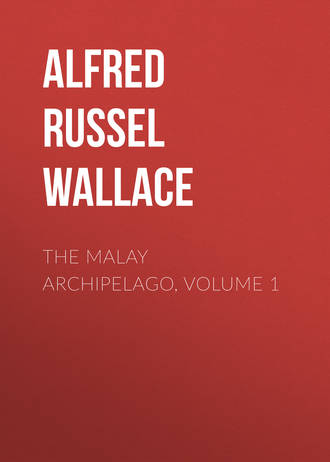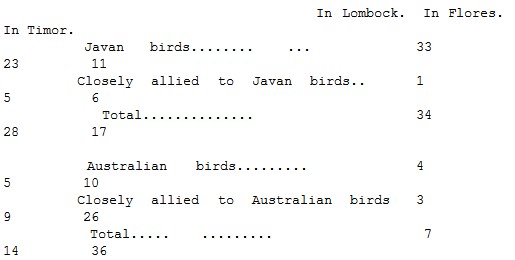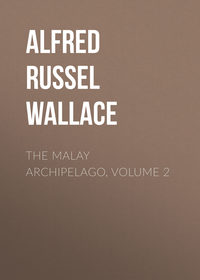 полная версия
полная версияThe Malay Archipelago, Volume 1
The Portuguese government in Timor is a most miserable one. Nobody seems to care the least about the improvement of the country, and at this time, after three hundred years of occupation, there has not been a mile of road made beyond the town, and there is not a solitary European resident anywhere in the interior. All the Government officials oppress and rob the natives as much as they can, and yet there is no care taken to render the town defensible should the Timorese attempt to attack it. So ignorant are the military officers, that having received a small mortar and some shells, no one could be found who knew how to use them; and during an insurrection of the natives (while I was at Delli) the officer who expected to be sent against the insurgents was instantly taken ill! And they were allowed to get possession of an important pass within three miles of the town, where they could defend themselves against ten times the force. The result was that no provisions were brought down from the hills; a famine was imminent; and the Governor had to send off to beg for supplies from the Dutch Governor of Amboyna.
In its present state Timor is more trouble than profit to its Dutch and Portuguese rulers, and it will continue to be so unless a different system is pursued. A few good roads into the elevated districts of the interior; a conciliatory policy and strict justice towards the natives, and the introduction of a good system of cultivation as in Java and northern Celebes, might yet make Timor a productive and valuable island. Rice grows well on the marshy flats, which often fringe the coast, and maize thrives in all the lowlands, and is the common food of the natives as it was when Dampier visited the island in 1699. The small quantity of coffee now grown is of very superior quality, and it might be increased to any extent. Sheep thrive, and would always be valuable as fresh food for whalers and to supply the adjacent islands with mutton, if not for their wool; although it is probable that on the mountains this product might soon be obtained by judicious breeding. Horses thrive amazingly; and enough wheat might be grown to supply the whole Archipelago if there were sufficient inducements to the natives to extend its cultivation, and good roads by which it could be cheaply transported to the coast.
Under such a system the natives would soon perceive that European government was advantageous to them. They would begin to save money, and property being rendered secure they would rapidly acquire new wants and new tastes, and become large consumers of European goods. This would be a far surer source of profit to their rulers than imposts and extortion, and would be at the same time more likely to produce peace and obedience than the mock-military rule which has hitherto proved most ineffective. To inaugurate such a system would however require an immediate outlay of capital, which neither Dutch nor Portuguese seem inclined to make, and a number of honest and energetic officials, which the latter nation at least seems unable to produce; so that it is much to be feared that Timor will for many years to come remain in its present state of chronic insurrection and misgovernment.
Morality at Delli is at as low an ebb as in the far interior of Brazil, and crimes are connived at which would entail infamy and criminal prosecution in Europe. While I was there it was generally asserted and believed in the place, that two officers had poisoned the husbands of women with whom they were carrying on intrigues, and with whom they immediately cohabited on the death of their rivals. Yet no one ever thought for a moment of showing disapprobation of the crime, or even of considering it a crime at all, the husbands in question being low half-castes, who of course ought to make way for the pleasures of their superiors.
Judging from what I saw myself and by the descriptions of Mr. Geach, the indigenous vegetation of Timor is poor and monotonous. The lower ranges of the hills are everywhere covered with scrubby Eucalypti, which only occasionally grow into lofty forest trees. Mingled with these in smaller quantities are acacias and the fragrant sandalwood, while the higher mountains, which rise to about six or seven thousand feet, are either covered with coarse grass or are altogether barren. In the lower grounds are a variety of weedy bushes, and open waste places are covered everywhere with a nettle-like wild mint. Here is found the beautiful crown lily, Gloriosa superba, winding among the bushes, and displaying its magnificent blossoms in great profusion. A wild vine also occurs, bearing great irregular bunches of hairy grapes of a coarse but very luscious flavour. In some of the valleys where the vegetation is richer, thorny shrubs and climbers are so abundant as to make the thickets quite impenetrable.
The soil seems very poor, consisting chiefly of decomposing clayey shales; and the bare earth and rock is almost everywhere visible. The drought of the hot season is so severe that most of the streams dry up in the plains before they reach the sea; everything becomes burned up, and the leaves of the larger trees fall as completely as in our winter. On the mountains from two to four thousand feet elevation there is a much moister atmosphere, so that potatoes and other European products can be grown all the year round. Besides ponies, almost the only exports of Timor are sandalwood and beeswax. The sandalwood (Santalum sp.) is the produce of a small tree, which grows sparingly in the mountains of Timor and many of the other islands in the far East. The wood is of a fine yellow colour, and possesses a well-known delightful fragrance which is wonderfully permanent. It is brought down to Delli in small logs, and is chiefly exported to China, where it is largely used to burn in the temples, and in the houses of the wealthy.
The beeswax is a still more important and valuable product, formed by the wild bees (Apis dorsata), which build huge honeycombs, suspended in the open air from the underside of the lofty branches of the highest trees. These are of a semicircular form, and often three or four feet in diameter. I once saw the natives take a bees' nest, and a very interesting sight it was. In the valley where I used to collect insects, I one day saw three or four Timorese men and boys under a high tree, and, looking up, saw on a very lofty horizontal branch three large bees' combs. The tree was straight and smooth-barked and without a branch, until at seventy or eighty feet from the ground it gave out the limb which the bees had chosen for their home. As the men were evidently looking after the bees, I waited to watch their operations. One of them first produced a long piece of wood apparently the stem of a small tree or creeper, which he had brought with him, and began splitting it through in several directions, which showed that it was very tough and stringy. He then wrapped it in palm-leaves, which were secured by twisting a slender creeper round them. He then fastened his cloth tightly round his loins, and producing another cloth wrapped it around his head, neck, and body, and tied it firmly around his neck, leaving his face, arms, and legs completely bare. Slung to his girdle he carried a long thin coil of cord; and while he had been making these preparations, one of his companions had cut a strong creeper or bush-rope eight or ten yards long, to one end of which the wood-torch was fastened, and lighted at the bottom, emitting a steady stream of smoke. Just above the torch a chopping-knife was fastened by a short cord.
The bee-hunter now took hold of the bush-rope just above the torch and passed the other end around the trunk of the tree, holding one end in each hand. Jerking it up the tree a little above his head he set his foot against the trunk, and leaning back began walking up it. It was wonderful to see the skill with which he took advantage of the slightest irregularities of the bark or obliquity of the stem to aid his ascent, jerking the stiff creeper a few feet higher when he had found a firm hold for his bare foot. It almost made me giddy to look at him as he rapidly got up—thirty, forty, fifty feet above the ground; and I kept wondering how he could possibly mount the next few feet of straight smooth trunk. Still, however, he kept on with as much coolness and apparent certainty as if he were going up a ladder, until he got within ten or fifteen feet of the bees. Then he stopped a moment, and took care to swing the torch (which hung just at his feet) a little towards these dangerous insects, so as to send up the stream of smoke between him and them. Still going on, in a minute more he brought himself under the limb, and, in a manner quite unintelligible to me, seeing that both hands were occupied in supporting himself by the creeper, managed to get upon it.
By this time the bees began to be alarmed, and formed a dense buzzing swarm just over him, but he brought the torch up closer to him, and coolly brushed away those that settled on his arms or legs. Then stretching himself along the limb, he crept towards the nearest comb and swung the torch just under it. The moment the smoke touched it, its colour changed in a most curious manner from black to white, the myriads of bees that had covered it flying off and forming a dense cloud above and around. The man then lay at full length along the limb, and brushed off the remaining bees with his hand, and then drawing his knife cut off the comb at one slice close to the tree, and attaching the thin cord to it, let it down to his companions below. He was all this time enveloped in a crowd of angry bees, and how he bore their stings so coolly, and went on with his work at that giddy height so deliberately, was more than I could understand. The bees were evidently not stupified by the smoke or driven away far by it, and it was impossible that the small stream from the torch could protect his whole body when at work. There were three other combs on the same tree, and all were successively taken, and furnished the whole party with a luscious feast of honey and young bees, as well as a valuable lot of wax.
After two of the combs had been let down, the bees became rather numerous below, flying about wildly and stinging viciously. Several got about me, and I was soon stung, and had to run away, beating them off with my net and capturing them for specimens. Several of them followed me for at least half a mile, getting into my hair and persecuting me most pertinaciously, so that I was more astonished than ever at the immunity of the natives. I am inclined to think that slow and deliberate motion, and no attempt at escape, are perhaps the best safeguards. A bee settling on a passive native probably behaves as it would on a tree or other inanimate substance, which it does not attempt to sting. Still they must often suffer, but they are used to the pain and learn to bear it impassively, as without doing so no man could be a bee-hunter.
CHAPTER XIV. THE NATURAL HISTORY OF THE TIMOR GROUP
IF we look at a map of the Archipelago, nothing seems more unlikely than that the closely connected chain of islands from Java to Timor should differ materially in their natural productions. There are, it is true, certain differences of climate and of physical geography, but these do not correspond with the division the naturalist is obliged to make. Between the two ends of the chain there is a great contrast of climate, the west being exceedingly moist and leaving only a short and irregular dry season, the east being as dry and parched up, and having but a short wet season. This change, however, occurs about the middle of Java, the eastern portion of that island having as strongly marked seasons as Lombock and Timor. There is also a difference in physical geography; but this occurs at the eastern termination of the chain where the volcanoes which are the marked feature of Java, Bali, Lombock, Sumbawa, and Flores, turn northwards through Gunong Api to Banda, leaving Timor with only one volcanic peak near its centre, while the main portion of the island consists of old sedimentary rocks. Neither of these physical differences corresponds with the remarkable change in natural productions which occurs at the Straits of Lombock, separating the island of that name from Bali, and which is at once so large in amount and of so fundamental a character, as to form an important feature in the zoological geography of our globe.
The Dutch naturalist Zollinger, who resided a long time on the island of Bali, informs us that its productions completely assimilate with those of Java, and that he is not aware of a single animal found in it which does not inhabit the larger island. During the few days which I stayed on the north coast of Bali on my way to Lombock, I saw several birds highly characteristic of Javan ornithology. Among these were the yellow-headed weaver (Ploceus hypoxantha), the black grasshopper thrush (Copsychus amoenus), the rosy barbet (Megalaema rosea), the Malay oriole (Oriolus horsfieldi), the Java ground starling (Sturnopastor jalla), and the Javanese three-toed woodpecker (Chrysonotus tiga). On crossing over to Lombock, separated from Bali by a strait less than twenty miles wide, I naturally expected to meet with some of these birds again; but during a stay there of three months I never saw one of them, but found a totally different set of species, most of which were utterly unknown not only in Java, but also in Borneo, Sumatra, and Malacca. For example, among the commonest birds in Lombock were white cockatoos and three species of Meliphagidae or honeysuckers, belonging to family groups which are entirely absent from the western or Indo-Malayan region of the Archipelago. On passing to Flores and Timor the distinctness from the Javanese productions increases, and we find that these islands form a natural group, whose birds are related to those of Java and Australia, but are quite distinct from either. Besides my own collections in Lombock and Timor, my assistant Mr. Allen made a good collection in Flores; and these, with a few species obtained by the Dutch naturalists, enable us to form a very good idea of the natural history of this group of islands, and to derive therefrom some very interesting results.
The number of birds known from these islands up to this date is: 63 from Lombock, 86 from Flores, and 118 from Timor; and from the whole group, 188 species. With the exception of two or three species which appear to have been derived from the Moluccas, all these birds can be traced, either directly or by close allies, to Java on the one side or to Australia on the other; although no less than 82 of them are found nowhere out of this small group of islands. There is not, however, a single genus peculiar to the group, or even one which is largely represented in it by peculiar species; and this is a fact which indicates that the fauna is strictly derivative, and that its origin does not go back beyond one of the most recent geological epochs. Of course there are a large number of species (such as most of the waders, many of the raptorial birds, some of the kingfishers, swallows, and a few others), which range so widely over a large part of the Archipelago that it is impossible to trace them as having come from any one part rather than from another. There are fifty-seven such species in my list, and besides these there are thirty-five more which, though peculiar to the Timor group, are yet allied to wide-ranging forms. Deducting these ninety-two species, we have nearly a hundred birds left whose relations with those of other countries we will now consider.
If we first take those species which, as far as we yet know, are absolutely confined to each island, we find, in:

The actual number of peculiar species in each island I do not suppose to be at all accurately determined, since the rapidly increasing numbers evidently depend upon the more extensive collections made in Timor than in Flores, and in Flores than in Lombock; but what we can depend more upon, and what is of more special interest, is the greatly increased proportion of Australian forms and decreased proportion of Indian forms, as we go from west to east. We shall show this in a yet more striking manner by counting the number of species identical with those of Java and Australia respectively in each island, thus:

Here we see plainly the course of the migration which has been going on for hundreds or thousands of years, and is still going on at the present day. Birds entering from Java are most numerous in the island nearest Java; each strait of the sea to be crossed to reach another island offers an obstacle, and thus a smaller number get over to the next island. [The names of all the birds inhabiting these islands are to be found in the "Proceedings of the Zoological Society of London" for the year 1863.] It will be observed that the number of birds that appear to have entered from Australia is much less than those which have come from Java; and we may at first sight suppose that this is due to the wide sea that separates Australia from Timor. But this would be a hasty and, as we shall soon see, an unwarranted supposition. Besides these birds identical with species inhabiting Java and Australia, there are a considerable number of others very closely allied to species peculiar to those countries, and we must take these also into account before we form any conclusion on the matter. It will be as well to combine these with the former table thus:

We now see that the total number of birds which seem to have been derived from Java and Australia is very nearly equal, but there is this remarkable difference between the two series: that whereas the larger proportion by far of the Java set are identical with those still inhabiting that country, an almost equally large proportion of the Australian set are distinct, though often very closely allied species. It is to be observed also, that these representative or allied species diminish in number as they recede from Australia, while they increase in number as they recede from Java. There are two reasons for this, one being that the islands decrease rapidly in size from Timor to Lombock, and can therefore support a decreasing number of species; the other and the more important is, that the distance of Australia from Timor cuts off the supply of fresh immigrants, and has thus allowed variation to have full play; while the vicinity of Lombock to Bali and Java has allowed a continual influx of fresh individuals which, by crossing with the earlier immigrants, has checked variation.
To simplify our view of the derivative origin of the birds of these islands let us treat them as a whole, and thus perhaps render more intelligible their respective relations to Java and Australia.
The Timor group of islands contains:
Javan birds....... 36 Australian birds… 13 Closely allied species.. 11 Closely allied species.. 35 Derived from Java .... 47 Derived from Australia… 48.
We have here a wonderful agreement in the number of birds belonging to Australian and Javanese groups, but they are divided in exactly a reverse manner, three-fourths of the Javan birds being identical species and one-fourth representatives, while only one-fourth of the Australian forms are identical and three-fourths representatives. This is the most important fact which we can elicit from a study of the birds of these islands, since it gives us a very complete clue to much of their past history.
Change of species is a slow process—on that we are all agreed, though we may differ about how it has taken place. The fact that the Australian species in these islands have mostly changed, while the Javan species have almost all remained unchanged, would therefore indicate that the district was first peopled from Australia. But, for this to have been the case, the physical conditions must have been very different from what they are now. Nearly three hundred miles of open sea now separate Australia from Timor, which island is connected with Java by a chain of broken land divided by straits which are nowhere more than about twenty miles wide. Evidently there are now great facilities for the natural productions of Java to spread over and occupy the whole of these islands, while those of Australia would find very great difficulty in getting across. To account for the present state of things, we should naturally suppose that Australia was once much more closely connected with Timor than it is at present; and that this was the case is rendered highly probable by the fact of a submarine bank extending along all the north and west coast of Australia, and at one place approaching within twenty miles of the coast of Timor. This indicates a recent subsidence of North Australia, which probably once extended as far as the edge of this bank, between which and Timor there is an unfathomed depth of ocean.
I do not think that Timor was ever actually connected with Australia, because such a large number of very abundant and characteristic groups of Australian birds are quite absent, and not a single Australian mammal has entered Timor—which would certainly not have been the case had the lands been actually united. Such groups as the bower birds (Ptilonorhynchus), the black and red cockatoos (Calyptorhynchus), the blue wrens (Malurus), the crowshrikes (Cracticus), the Australian shrikes (Falcunculus and Colluricincla), and many others, which abound all over Australia, would certainly have spread into Timor if it had been united to that country, or even if for any long time it had approached nearer to it than twenty miles. Neither do any of the most characteristic groups of Australian insects occur in Timor; so that everything combines to indicate that a strait of the sea has always separated it from Australia, but that at one period this strait was reduced to a width of about twenty miles.
But at the time when this narrowing of the sea took place in one direction, there must have been a greater separation at the other end of the chain, or we should find more equality in the numbers of identical and representative species derived from each extremity. It is true that the widening of the strait at the Australian end by subsidence, would, by putting a stop to immigration and intercrossing of individuals from the mother country, have allowed full scope to the causes which have led to the modification of the species; while the continued stream of immigrants from Java, would, by continual intercrossing, check such modification. This view will not, however, explain all the facts; for the character of the fauna of the Timorese group is indicated as well by the forms which are absent from it as by those which it contains, and is by this kind of evidence shown to be much more Australian than Indian. No less than twenty-nine genera, all more or less abundant in Java, and most of which range over a wide area, are altogether absent; while of the equally diffused Australian genera only about fourteen are wanting. This would clearly indicate that there has been, until recently, a wide separation from Java; and the fact that the islands of Bali and Lombock are small, and are almost wholly volcanic, and contain a smaller number of modified forms than the other islands, would point them out as of comparatively recent origin. A wide arm of the sea probably occupied their place at the time when Timor was in the closest proximity to Australia; and as the subterranean fires were slowly piling up the now fertile islands of Bali and Lombock, the northern shores of Australia would be sinking beneath the ocean. Some such changes as have been here indicated, enable us to understand how it happens, that though the birds of this group are on the whole almost as much Indian as Australian, yet the species which are peculiar to the group are mostly Australian in character; and also why such a large number of common Indian forms which extend through Java to Bali, should not have transmitted a single representative to the island further east.
The Mammalia of Timor as well as those of the other islands of the group are exceedingly scanty, with the exception of bats. These last are tolerably abundant, and no doubt many more remain to be discovered. Out of fifteen species known from Timor, nine are found also in Java, or the islands west of it; three are Moluccan species, most of which are also found in Australia, and the rest are peculiar to Timor.









